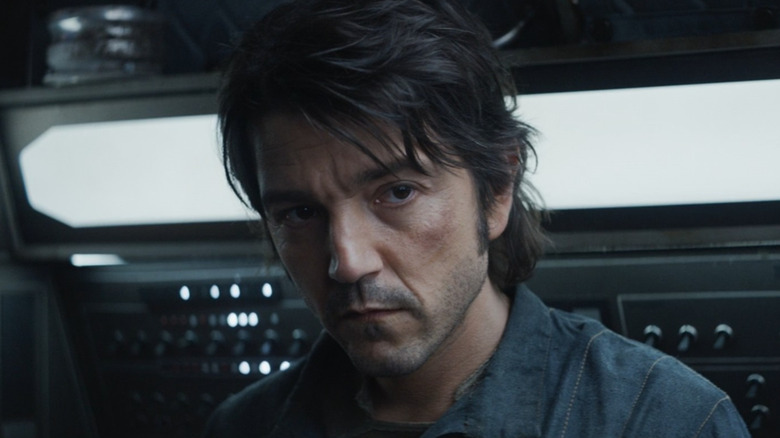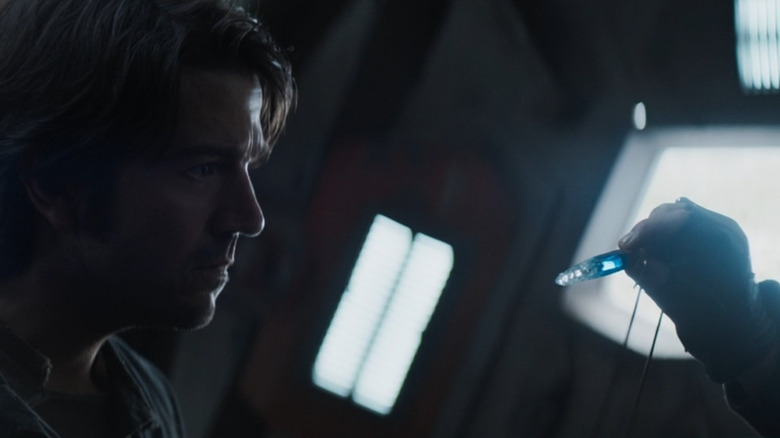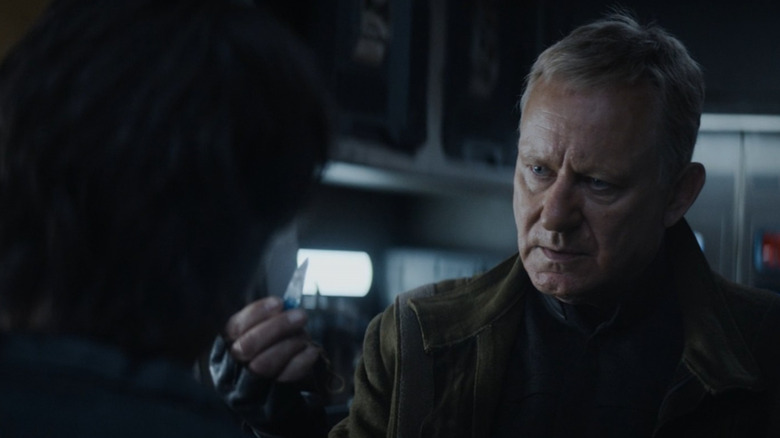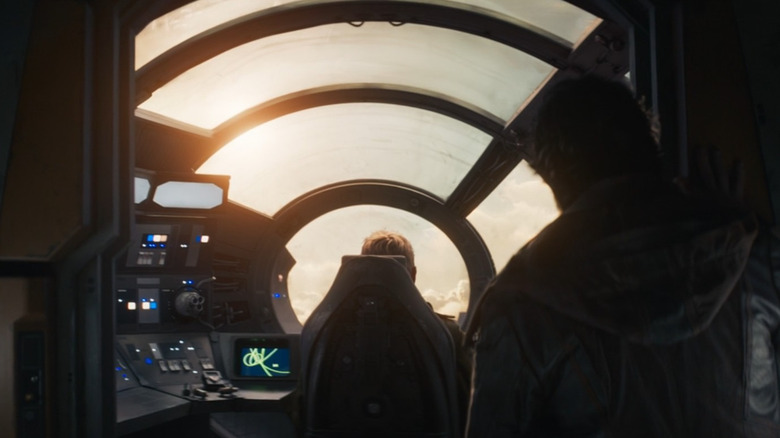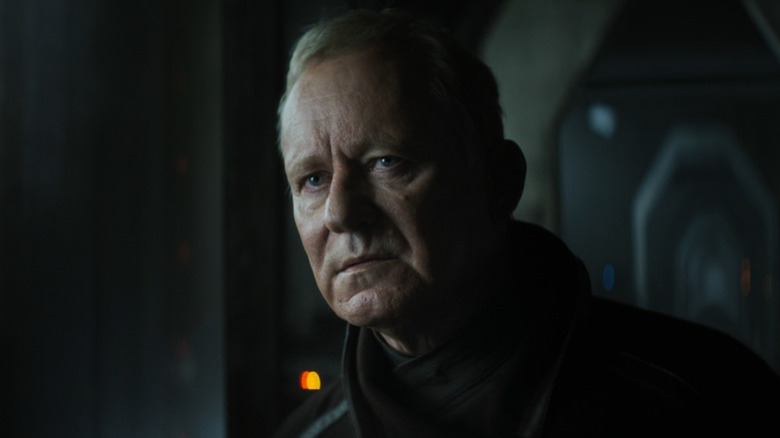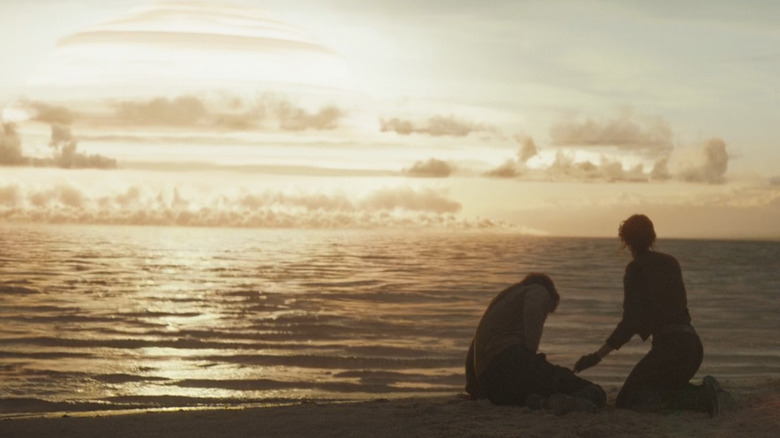Star Wars: Andor's Necklace Is A Lot More Important Than You May Think
"Andor" is a show filled with symbolism. A revolutionary voice fighting against oppression is literally crushed under the weight of Imperial capital. The ashes of a grassroots leader are baked into a brick that's used to bash in the heads of an occupying police force. Part of why the Star Wars TV series has earned so much praise is its fierce attention to detail. No bare foot, pipe bomb, or celestial event is placed by accident.
That also extends to the symbols that reference previous Star Wars stories. "Andor" is pretty selective in its use of franchise iconography, holding stormtroopers until much later on Season 1 and using TIE fighters so sparingly that they actually become quite terrifying. But perhaps no object from the property's past is as curious as the necklace that Luthen Rael (Stellan Skarsgård) gives to Cassian Andor (Diego Luna) early on the show.
Ostensibly, it's just a collateral payment — a gesture from Luthen to prove that he's not some scam artist looking to leave Cassian high and dry. However, the necklace has layers of deeper significance, some tied to Star Wars history, and others relating to the show's larger themes. Here's why Andor's necklace is more important than you think.
Andor's necklace is a kyber crystal -- but what does that mean?
Luthen gives Cassian the necklace after their daring escape from a corporate hit squad on Ferrix. Their scene together on Luthen's ship, the Fondor, is one of the show's most important, as it lays out where both men stand ideologically. Cassian insists he'd rather be let off at the next planet and take his chances solo than join whatever mission Luthen is on. He rattles off a laundry list of rebel factions and declares that they're all the same to him, to which Luthen agrees, arguing the case for a larger, unified movement.
The promise of 200,000 credits is enough to make Cassian join up for the payroll heist on Adhani, but just to make sure, Luthen gives him a special down payment. "It's a Kuati Signet," the mysterious spymaster tells him. "Blue kyber. Sky Stone. The ancient world." Any Jedi nerd or longtime Star Wars fan will know that kyber crystals power all lightsabers. It was a rite of passage in the old days of the Order for younglings to voyage to the planet Ilum and retrieve their own kyber crystals from its caves to forge their first blades.
The other labels Luthen gives the pendant — Kuati Signet and Sky Stone — don't have the same established context. Kuati theoretically is a reference to Kuat, a Galactic Core planet famous for its shipyards, especially during the Imperial era. "Sky Stone" is likely the oldest of the three signifiers Luthen says — a potential reference to the "ancient world" he claims the necklace comes from.
Does the necklace in Andor mean Luthen is a secret Jedi?
Once you know that the "Andor" necklace is a kyber crystal and that Jedi use kyber crystals to power their lightsabers, the natural question is whether or not Luthen is actually a Jedi. This remains one of the biggest unanswered questions from "Andor" Season 1, and the pendant isn't the only clue that the spymaster might be more than he seems.
There's the extendable walking stick, lightsaber-esque in form and function, which is examined curiously by guards when Luthen visits Saw Gerrera (Forest Whitaker). There's the Darth Vader closet cosplay during his iconic monologue on Episode 10, and the contents of that monologue, which refer to a kind of spiritual damnation. Is Luthen a Jedi? The show certainly wants you to ask that question, but that doesn't mean the answer is yes.
Luthen is an enigma. His cover as an antique dealer on Coruscant could have easily allowed him access to something like a kyber pendant. There are some other curious artifacts in the background of his shop, including a pair of holocrons, which further suggest a Jedi connection. Of course, those could just be one of the rare Easter eggs on "Andor," so it's hard to say for sure.
Andor's necklace may reveal a bond stronger than Star Wars fans think
Perhaps the biggest argument for Luthen being a secret Jedi is how attached he seems to be to the kyber necklace. In the scene where he gives it to Cassian, we see him take it off his own neck, suggesting he wears it regularly. Reading the body language, you could infer that this is a spur-of-the-moment decision. "Don't take less than 50,000 for it," Luthen says after handing it over. "Just know it will always be worth more to me." The pendant conveys a sense of trust just as much as it does monetary reward. It could suggest a unique bond between the two — a sign that Luthen sees something of himself in Cassian and needs him to join for personal reasons as well as strategic ones.
The problem is that elsewhere on the show, we see Luthen openly lie to other operatives in order to keep things running smoothly. He lies to Lonni Jung (Robert Emms), his spy in the Imperial Security Bureau, and claims that he had nothing to do with the Aldhani heist. We also see him manipulate Lonni in the same scene, telling him that he's a hero to the cause but assuring him that there's no way he could possibly get out of the spy business safely. In his scenes with Saw Gerrera, Luthen tells more lies.
While there's much we don't know for sure about Luthen, we do know that his main priority is the success of the Rebellion. He rattles off his many sacrifices in his conversation with Lonni, and he confesses to Kleya (Elizabeth Dulau) that he wanted Aldhani to work "too much." Because he "wasn't careful" with Cassian, he puts a hit out on him. So, is the kyber necklace really a symbol of some deep ideological bond? Or is it just one of many such trinkets in Luthen's storage room, waiting to be handed out to would-be rebels?
Andor's kyber necklace is a symbol of revolution from Star Wars history
In addition to its Jedi connection, the kyber necklace Luthen gives to Cassian has an older significance in the Star Wars universe. After rattling off the various names for the pendant, Luthen claims that it "celebrates the uprising against the Rakatan invaders."
The Rakata are a species hailing from the old Star Wars Expanded Universe — specifically, the 2003 video game "Star Wars: Knights of the Old Republic." There, it's revealed to the player that the galaxy was first brought under a single banner by the Rakatan Infinite Empire, an early spacefaring faction of conquerors from the ancient past. The Rakata were able to amass immense strength through the development of early hyperdrive technology, expanding their realm of influence.
Not much about the Rakata has been brought over from the Legends timeline to the current Star Wars canon, but Luthen's brief reference suggests that the basics are the same. The signet, if he's telling the truth, is a longstanding symbol of resistance against imperial oppression. It's as if he's telling Cassian that no matter what he may believe, it is possible to fight the powers that be. After all, it's been done before, as far back as the early days of galactic civilization.
The fact that it's a "Kuati Signet" also plays into that symbolism, as Kuat's main role under the Empire is building weapons of war — specifically ships, which is how the Rakata became so powerful in the EU. If Kuat managed to fight back against domination in the "ancient world," as Luthen says, then maybe there's hope for the future.
The Andor necklace has a Rogue One connection
As of now, we don't know exactly what happens to the kyber necklace on "Andor." Cassian gives it to Vel (Faye Marsay) after the Aldhani heist and tells her to give it back to Luthen for him, but we never see that happen. Vel doesn't see Luthen in person again until the end of "Andor" Season 1 when they reunite on Ferrix. It's clear from her scene with Kleya that there's some tension there (and major exes vibes, but that's a topic for another day). More than likely, Vel is still holding onto the pendant to give back to Luthen personally.
While that exact necklace hasn't popped up again yet, there is one very similar to it in "Rogue One: A Star Wars Story," but it doesn't belong to Andor. Instead, Jyn Erso (Felicity Jones) is given a nearly identical necklace by her mother (Valene Kane), right before her parents are killed by Imperial Death troopers. This item is given more explicit religious significance, with Jyn's mother telling her to "trust the Force" when she gives it to her. Unlike the blue "Sky Stone" kyber of Luthen's necklace, which seems to hold special significance and evokes the blue lightsabers of the Jedi, Jyn's crystal is white.
It's possible that the necklace actually came from Jyn's father Galen (Mads Mikkelsen), who conducted extensive research on kyber-based energy systems for the Empire. That research ultimately begets the Death Star superlaser, the weapon that kills both Jyn and Cassian at the end of "Rogue One." It's interesting to say the least that the very thing that takes their lives is also a symbol of resilience and rebellion for them both.
